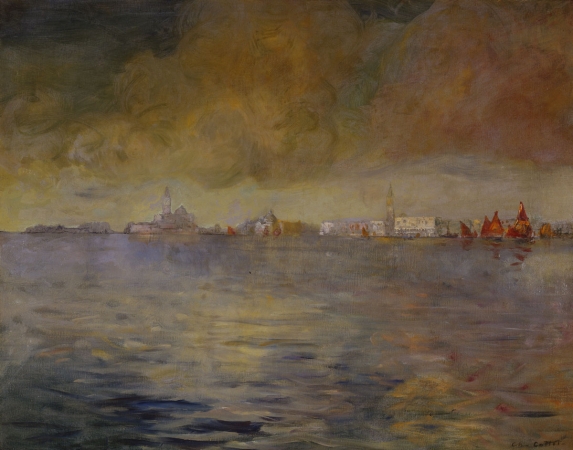COTTET, Venice

Charles COTTET (1863-1925)
Venice
ca.1895-1896
oil on canvas
73.2 x 92.5 cm
© MuMa Le Havre / Florian Kleinefenn
Venice
ca.1895-1896
oil on canvas
73.2 x 92.5 cm
© MuMa Le Havre / Florian Kleinefenn
HD image
In 1896, Charles Cottet exhibited at the Salon de l’Art Nouveau a series of paintings brought back from a trip to Venice he had made two years earlier. Thadée Natanson, defender of the Nabi movement, wrote an article in La Revue Blanche on Cottet's views of the Venetian lagoon: "Venice is not what his art describes, nor is Venice the subject of his notes: not the legendary floating city, not the shimmering canals, not the splendour of the palaces shining in the bright sun, not the gondolas nor their colourful drivers. What occupied him [...] was the sea, the sea with its mist, the sea and its colours filled with intense or icy light, the sea from which Venice originates, but above all the sea with its clouds wrapped in banners of all colours, the waves of opalized ashen jade; the dark waves, the blood-red waves, the brilliant islets, the glory of the waves [...] the waves with glints of molten metal [...]"
Indeed, Charles Cottet avoided all stereotypes and local clichés to recreate highly original views of Venice. Comprised of a strip of water and a strip of sky joined at an almost intangible horizon line upon which the artist set the ghostly cityscape, the artwork is a prime illustration of Cottet’s astonishing paintwork. The texture of his painting is so fluid all the contours of the buildings appear to be done in a wash. Muted blacks and barely shaded greys delicately delineate the blocks that gradually become tinged with the pale light of the setting sun. The reflection of the churches and palaces in the water is but a shapeless shimmer, with a transparency that calls to mind a glaze. The background of the painting was evenly brushed with an undercoat of grey, which the artist lets show through in his sky and within the outlines of the buildings. The central section is the finest part of the artwork, demonstrating a rare mastery of execution.
Indeed, Charles Cottet avoided all stereotypes and local clichés to recreate highly original views of Venice. Comprised of a strip of water and a strip of sky joined at an almost intangible horizon line upon which the artist set the ghostly cityscape, the artwork is a prime illustration of Cottet’s astonishing paintwork. The texture of his painting is so fluid all the contours of the buildings appear to be done in a wash. Muted blacks and barely shaded greys delicately delineate the blocks that gradually become tinged with the pale light of the setting sun. The reflection of the churches and palaces in the water is but a shapeless shimmer, with a transparency that calls to mind a glaze. The background of the painting was evenly brushed with an undercoat of grey, which the artist lets show through in his sky and within the outlines of the buildings. The central section is the finest part of the artwork, demonstrating a rare mastery of execution.
















